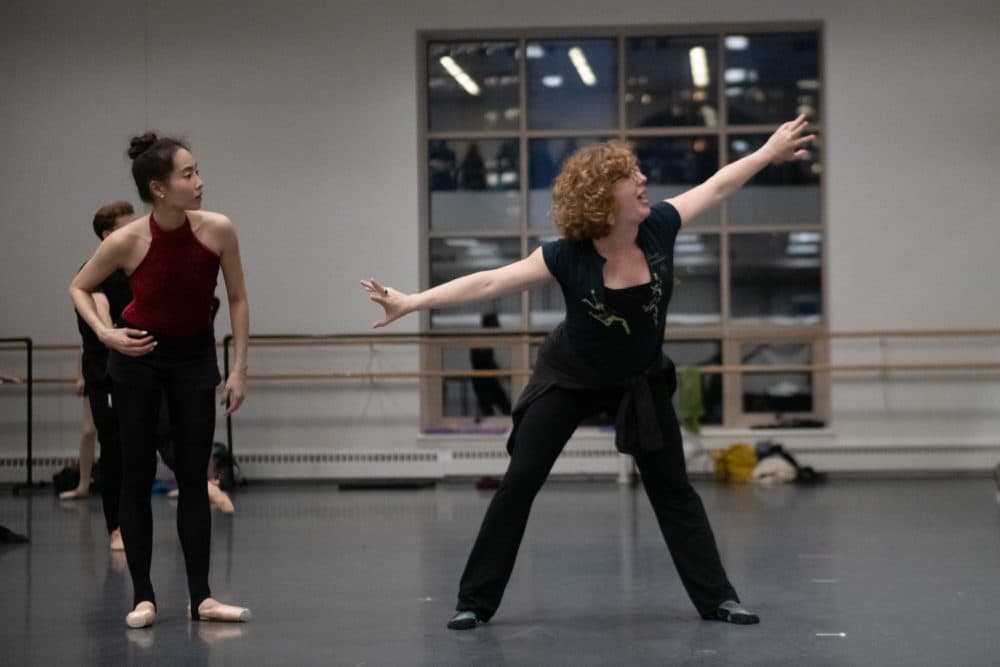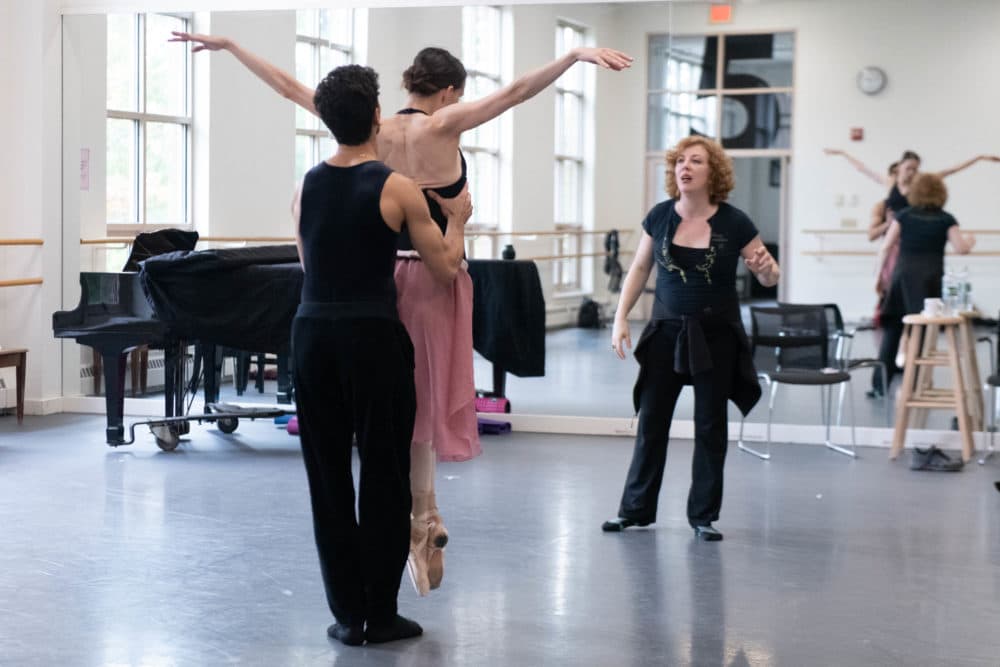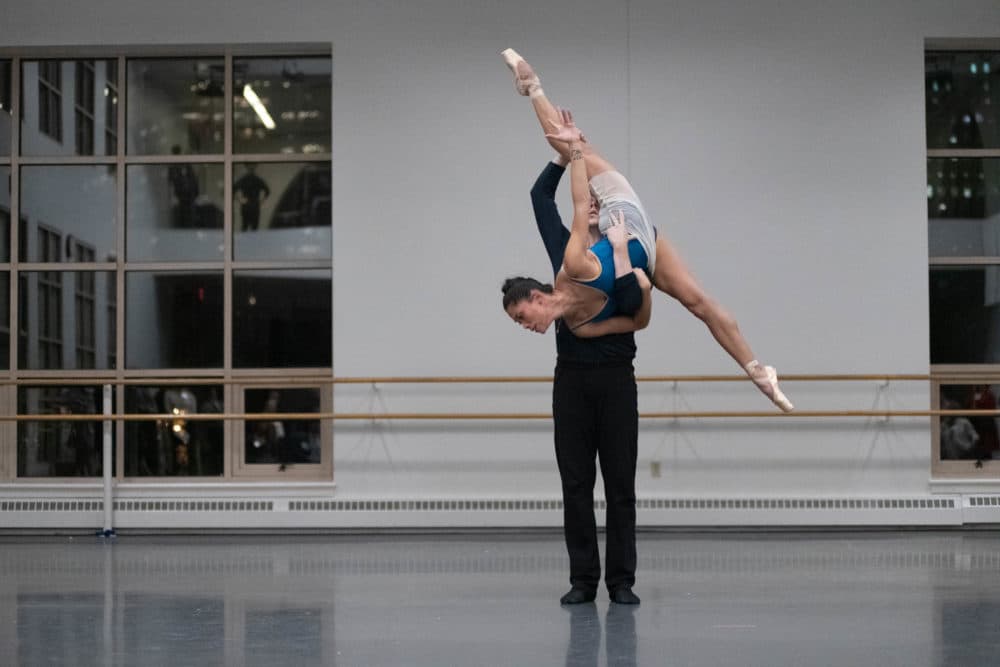Advertisement
Choreographer Helen Pickett Explores Femininity With Boston Ballet

Choreographer Helen Pickett approaches her art in an intellectual way. She refers to music, literature, painting, design, philosophy and history. Her latest big project is “The Crucible,” an award-winning full-length work for the Scottish Ballet, on the weighty subject of the Salem witch trials. And yet, there’s something of the flower child in Helen Pickett. Not the flakey kind, but rather a force-of-nature type.
“I always thought I could have been a florist,” Pickett said of her ballet “Petal,” which has been evolving since 2007, and is part of Boston Ballet’s upcoming “Carmen” program. “My brain’s really oriented toward smell and the color, it’s always ignited my sensory system,” she continued. “Nature doesn’t try. It ‘is’ in its vigor and its beauty. It just ‘is.’ And it’s that ‘is’ of nature that inspired ‘Petal.’ The whole exercise of ‘Petal’ is to take the artifice of performing away and give the dancer onstage their individuality, their nature.”
“Petal” is one of two Pickett works included in the “Carmen” program, whose title is also the name of the program’s Bizet-opera-inspired piece by Jorma Elo. Also included is the 1935 classic “Serenade,” the first work George Balanchine choreographed in America.
The company’s stated goal of the “Carmen” program is to explore and celebrate many facets of femininity. How do these four short ballets — two by men and two by a woman — address the subject of being female? How are they all about women?
“Basically, George Balanchine’s ‘Serenade’ is about femininity, it’s about regular women turning into dancers. Epic, classic, the ultimate feminine brilliant ballet,” said Mikko Nissinen, Boston Ballet’s artistic director. “And Helen Pickett is the creative female force, and we see ‘Tsukiyo’ and ‘Petal’ from her. And then there’s another really strong woman, ‘Carmen,’ in the Jorma Elo choreography.”
One of the first to experience Pickett’s focused strength when she began choreographing is Boston Ballet principal dancer Lia Cirio. A teenager when she first encountered Pickett, Cirio was scared of her. “Helen is very opinionated, and because she’s had an amazing career and danced everywhere, and has choreographed for so many companies, she has really refined taste,” Cirio said. “She’s a force. She has her way of movement. But we’ve taken it through osmosis. We watch her, the way that she uses her head and the way that she uses her arms, and it becomes us.”
Advertisement
Nissinen spotted Pickett’s talent early on and described her style. “She usually has a very strong concept of where she wants to start. She tends to compile material as her starting point. She seems to distill from there, keeping something, changing something. She definitely comes to the starting line with lots of ideas and images and different artists, and this and that literature.”

It’s not surprising that Pickett comes to the studio deeply-prepared when you consider her multifaceted career before she ever tried choreographing.
A member of Ballett Frankfurt for more than a decade during William Forsythe’s tenure, Pickett has also acted on stage — she performed with New York theater company The Wooster Group for five years — and in films. She has fine arts degrees and an honorary doctorate.
Perhaps, in part, because of her wide-ranging experience, Pickett projects confidence, wit and a colorful, unique personality. Since 2005, she’s created five new works at Boston Ballet, where principal dancer Paul Craig said, “When she walks into a room, you know it and everyone can feel it. She’s this short, curly-redhead spitfire of a human being. Her energy is intoxicating and infectious. She’s loud and proud.”
The dance-making part of Pickett’s career began when Nissinen left a voicemail on her home phone. “He called me in May 2005 and left a message asking whether I wanted to create a work for Boston Ballet,” Pickett recalled.
“It’s one of those messages that you go, like, ‘What? Did I hear this right?’ So I had my husband listen to it and he said, ‘Yeah, he’s asking you to make a piece.’ I’ve always been a kind of ‘you may as well say yes to things, challenges, why not?’ person. And this is something I actually wanted.”
Since then, Pickett has been in continuous demand and now has choreographed more than 40 ballets for companies in North America and Europe. This season, she created works for Boston Ballet, Kansas City Ballet, Charlotte Ballet, and Canada’s Alberta Ballet.

“Tsukiyo,” based on the Japanese fable of “The Woodcutter’s Daughter,” is the second Pickett piece in the program.
“’Tsukiyo’ is like a love letter,” she said. “What I always say to the dancers is this: ‘The walk up the stairs is the best part of the affair.’ It’s about anticipation and the ‘what if.’ And that alone excites human beings to no end. Entices them to sit forward. ‘Tsukiyo’ is extremely intimate. It’s not the prowess of partnering so much as the choice and delicacy of touch, and what touch actually does to human beings.”
Exploring intimacy and delicacy rather than the prowess of the dancer may be inevitable with female choreographers. Or may not. With the “Carmen” program, Boston Ballet’s audience can experience the artistic instincts of the male versus female creator of ballets. And it’s not unusual for this company. In the past several years, Nissinen has expanded opportunities for women to choreograph. “I’m very curious to see the woman as a creator versus as a muse,” he said. “Instead of being the inspiration, what is it that the women want to say as creative artists versus interpretative artists? And naturally, the stories they want to tell and the perspective they put on things is different. And I find that very fascinating.”
The “Carmen” program is emblematic of the dance world’s evolving image of women. Half of the pieces are by men, interestingly, including Balanchine, who famously said “Ballet is woman.” The retort from choreographer Pam Tanowitz (and others) is that ballet is man’s idea of a woman.
The other half of the program is work created by Pickett — Not her be-all and end-all notion of what it is to be a woman. Just work from a female sensibility, a woman’s perspective. And we move on from there.
Boston Ballet’s “Carmen” is at the Citizens Bank Opera House March 12-22.
UPDATE: Due to the impact of COVID-19, the Boston Ballet announced it has decided to reschedule all performances of "Carmen" to August 20-30.
